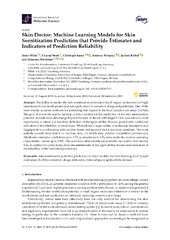| dc.contributor.author | Wilm, Anke | |
| dc.contributor.author | Stork, Conrad | |
| dc.contributor.author | Bauer, Christoph | |
| dc.contributor.author | Schepky, Andreas | |
| dc.contributor.author | Kühnl, Jochen | |
| dc.contributor.author | Kirchmair, Johannes | |
| dc.date.accessioned | 2020-05-13T09:54:13Z | |
| dc.date.available | 2020-05-13T09:54:13Z | |
| dc.date.issued | 2019-09-28 | |
| dc.Published | Wilm A, Stork C, Bauer C, Schepky, Kühnl J, Kirchmair J. Skin Doctor: Machine learning models for skin sensitization prediction that provide estimates and indicators of prediction reliability. International Journal of Molecular Sciences. 2019 ,20(19), 4833 | eng |
| dc.identifier.issn | 1422-0067 | en_US |
| dc.identifier.uri | https://hdl.handle.net/1956/22221 | |
| dc.description.abstract | The ability to predict the skin sensitization potential of small organic molecules is of high importance to the development and safe application of cosmetics, drugs and pesticides. One of the most widely accepted methods for predicting this hazard is the local lymph node assay (LLNA). The goal of this work was to develop in silico models for the prediction of the skin sensitization potential of small molecules that go beyond the state of the art, with larger LLNA data sets and, most importantly, a robust and intuitive definition of the applicability domain, paired with additional indicators of the reliability of predictions. We explored a large variety of molecular descriptors and fingerprints in combination with random forest and support vector machine classifiers. The most suitable models were tested on holdout data, on which they yielded competitive performance (Matthews correlation coefficients up to 0.52; accuracies up to 0.76; areas under the receiver operating characteristic curves up to 0.83). The most favorable models are available via a public web service that, in addition to predictions, provides assessments of the applicability domain and indicators of the reliability of the individual predictions. View Full-Text Keywords: skin sensitization potential; prediction; in silico models; machine learning; local lymph node assay (LLNA); cosmetics; drugs; pesticides; chemical space; applicability domain | en_US |
| dc.language.iso | eng | eng |
| dc.publisher | MDPI | en_US |
| dc.rights | Attribution CC BY | eng |
| dc.rights.uri | http://creativecommons.org/licenses/by/4.0/ | eng |
| dc.title | Skin Doctor: Machine learning models for skin sensitization prediction that provide estimates and indicators of prediction reliability | en_US |
| dc.type | Peer reviewed | |
| dc.type | Journal article | |
| dc.date.updated | 2020-02-19T07:28:58Z | |
| dc.description.version | publishedVersion | en_US |
| dc.rights.holder | Copyright 2019 The Author(s) | en_US |
| dc.identifier.doi | https://doi.org/10.3390/ijms20194833 | |
| dc.identifier.cristin | 1748200 | |
| dc.source.journal | International Journal of Molecular Sciences | |
| dc.relation.project | Trond Mohn stiftelse: BFS2017TMT01 | |

